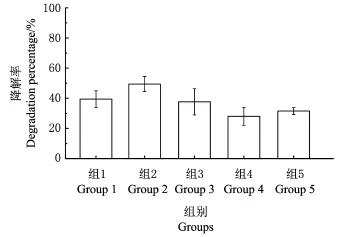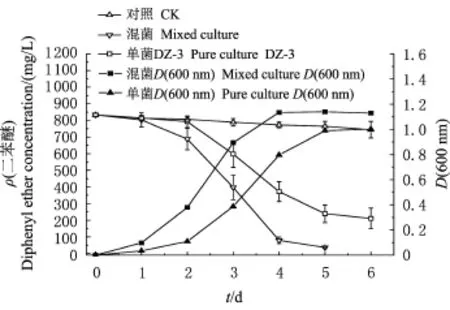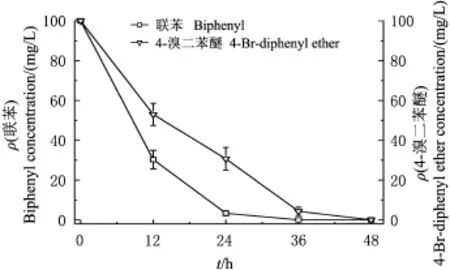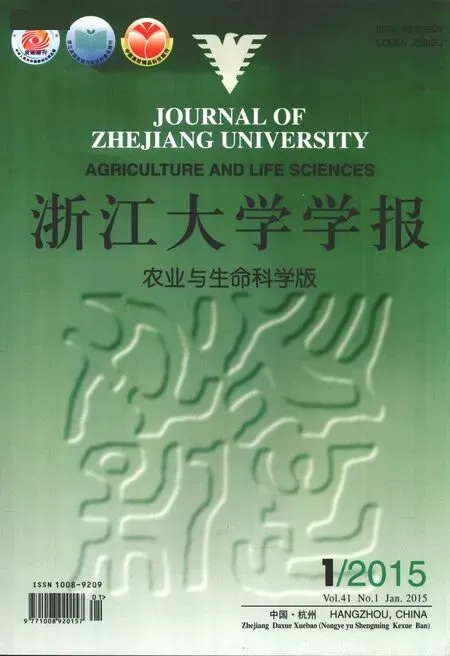二苯醚降解菌鞘氨醇单胞菌DZ-3的分离及其降解特性
2015-06-05冯琢王晟白娜玲赵宇华
冯琢,王晟,白娜玲,赵宇华
(浙江大学生命科学学院微生物研究所,杭州310058)
二苯醚降解菌鞘氨醇单胞菌DZ-3的分离及其降解特性
冯琢,王晟,白娜玲,赵宇华*
(浙江大学生命科学学院微生物研究所,杭州310058)
通过选择性富集从浙江上虞污水处理厂的活性污泥中分离获得2株细菌DZ-3和CZ-3.DZ-3能够以二苯醚为唯一碳源进行生长,CZ-3不能对二苯醚进行降解,但CZ-3和DZ-3的混合培养物能极大地提高对二苯醚的降解效率.对这2株菌进行16S r DNA鉴定,分别隶属于鞘氨醇单胞菌属(Sphingomonas sp.)以及苍白杆菌属(Ochrobactrum sp.).无机盐降解实验表明,DZ-3在6 d内对初始质量浓度为835 mg/L的二苯醚的降解率为71%,而混合细菌以2∶3比例接种在4 d内的降解率为90%.通过人工神经网络的方法分析无机盐中金属离子对二苯醚降解效率的影响表明,Mg2+对降解的影响最大.在土壤中的降解实验表明,混合细菌在6 d内对土壤中二苯醚的降解率能够达到98%.
二苯醚;降解细菌;降解率;土壤修复
SummaryPolybrominated diphenyl ethers(PBDEs)are man-made flame-retardant chemicals that are widely used to decrease the flammability of plastics,electronic appliances,textiles and polyurethanes.Annually,more than 67 400 tons of PBDEs including penta-,octa-,and deca-BDE were produced.PBDEs can be incorporated into polymers without any covalent bonds to adjacent materials.Because of the widespread production and improper disposal of these polymers,PBDEs have been accumulated in the environment.The toxicity of PBDEs is variable for different congeners.Some of them show neurotoxic toxicity in mice and dioxin-like endocrine disruption.In spite of the accumulation of PBDEs in the environment,few remediation technologies have been investigated sufficiently.A few works of biological degradation of PBDEs have been done in recent years.
An efficient diphenyl ether degrading bacterium strain DZ-3,which was able to utilize diphenyl ether as a sole source of carbon and energy under aerobic condition,was isolated from activated sludge of a wastewater treatment plant.The growth and degradation character of the strain were studied in order to offer some useful informations for the remediation of contamination.
In addition to the diphenyl ether degrading bacterium DZ-3,the other bacterium strain CZ-3 was also isolated,which can’t degrade biphenyl ether.But the mixed cultures of the two strains could enhance the degradation ofdiphenyl ether compared with DZ-3 cultivation.Based on 16S r DNA gene sequencing,the strains DZ-3 and CZ-3 were identified as Sphingomonas sp.DZ-3 and Ochrobactrum sp.CZ-3.Mixture design was used to adjust the proportion of each strain and the optimal ratio of inoculation size was DZ-3∶CZ-3=2∶3.Diphenyl ether degradation experiments using high performance liquid chromatograph(HPLC)showed that the strain DZ-3 could degrade 71%of diphenyl ether(initial concentration of 835 mg/L)within 6 days,while the mixture of DZ-3 and CZ-3 could degrade 90%within 4 days.To further investigate the degree of metal ions affecting the biodegradation of Sphingomonas sp.DZ-3,a background propagation artificial neural network(ANN)was used to conduct a sensitive analysis on the individual variables.The ANN model showed satisfactory fits for the experimental data. The results indicated that Mg2+appeared to be the most important metal ion for the biodegradation of DZ-3 with a relative importance of 31.01%,followed by Co2+(25.45%),Ni2+(15.12%),in which Mg2+had a positive effect on the degradation,while Co2+and Ni2+had negative ones.In addition,the strain DZ-3 even catabolized biphenyl and monobrominated diphenyl ether.Meanwhile,the degradation of biphenyl ether in the polluted soil added with the exterior microorganism was studied by lab simulation.In lab simulation,the degradation percentage of diphenyl ether by Ochrobactrum sp.CZ-3 and Sphingomonas sp.DZ-3 was 71%within 3 days and 98%within 6 days.The degradation effect was significant,indicating that the mixed culture had great potential for remediation of contaminated soil.
In conclusion,the research on the characteristics of the diphenyl ether biodegradation can provide theoritical basis and experience about engineering application for bioremediation of diphenyl ether and PBDEs polluted sites.
多溴联苯醚(polybrominated diphenyl ethers,PBDEs)作为一种主要的溴代阻燃剂,其阻燃效率高,热稳定性好,添加量少,因此被广泛应用于各种工业产品中,包括纺织品、电子电气设备、建筑装饰材料等[12].3种主要的PBDEs混合物商品有:deca-BDEs,octa-BDEs和penta-BDEs.PBDEs的年产量已达67 400 t[3].不同于其他溴代阻燃剂如四溴双酚A,PBDEs是直接添加到高分子聚合物中,不通过任何化学键与其相连,因此这些化学物质更容易扩散到环境中[4].由于PBDEs在环境中稳定,不会被分解,它们会长期积累在环境中.从20世纪90年代开始,科学家就开始了PBDEs对环境以及动物毒性的研究.发现动物在长期接触溴代阻燃剂的环境下大脑发育会变得不正常,并影响其记忆、学习能力及行为表现,部分溴代阻燃剂会干扰甲状腺及女性荷尔蒙的分泌[56].不同PBDE同系物毒性差别很大,研究表明高溴代PBDEs溶解在有机溶剂中时,在紫外光照射下会发生脱溴反应,产生毒性更强的低溴代PBDEs[79].而且PBDEs在制备、燃烧以及高温分解时会产生剧毒致癌物多溴二苯并二噁英及多溴二苯并呋喃(PBDD/Fs)[10].2009年,联合国环境规划署发表声明,将四溴联苯醚、五溴联苯醚、六溴联苯醚和七溴联苯醚等9种有毒物质列入《关于持久性有机污染物的斯德哥尔摩公约》.含有PBDEs的产品在生产、使用以及废物处置阶段都会不同程度地释放出PBDEs,污染环境.
微生物修复技术是一种绿色、经济、环保的修复技术.因此,培养筛选出对二苯醚以及多溴联苯醚具有高效降解能力的菌株使之应用于含多溴联苯醚土壤的处理具有非常重要的意义[11].1992年,Schmidt等首次分离出了能够以二苯醚为唯一碳源和能源生长的菌株鞘氨醇单胞菌Sphingomonas sp.SS3[1213].2007年,Kim等[14]从污水处理厂的污泥中分离到一株Sphingomonas sp.PH-07,发现该菌能够以二苯醚为唯一碳源和能源生长,在6 d内能将质量浓度为1 g/L二苯醚降解完全,并且能够共代谢4-溴二苯醚、2,4-二溴联苯醚.在被报道的菌株中,大部分都只能以二苯醚为生长底物对PBDEs进行共代谢降解,不能以含有2个溴以上的PBDEs为唯一碳源和能源生长,其中溴原子取代位置极大地影响微生物对其的代谢[1517].在本文中我们分离到1株能够以二苯醚为唯一碳源进行生长的细菌,并对其降解特性进行了研究.
1 材料与方法
1.1 材料
1.1.1 样品来源 用于进行降解菌筛选的污泥来自浙江上虞污水处理厂曝气池池底污泥.
1.1.2 主要试剂和仪器 二苯醚、4-溴二苯醚购自阿拉丁试剂公司;二甲亚砜购自美国Sigma公司;其他试剂均为色谱纯或分析纯国产试剂;用于PCR扩增的全套试剂均购自日本TaKaRa公司,引物合成以及测序由生工生物工程(上海)股份有限公司完成. PCR仪(美国Bio-Rad公司),KQ5200DE数控超声清洗器(江苏省昆山市超声仪器有限公司),Agilent 1200高效液相色谱仪(安捷伦科技有限公司).
1.1.3 培养基 LB培养基:蛋白胨10 g/L、酵母粉5 g/L、NaCl 10 g/L、蒸馏水,p H 7.0,2%琼脂粉,121℃、20 min灭菌.
无机盐培养基:Na2HPO4·12H2O 7.036 5 g/L、KH2PO41 g/L、(NH4)2SO40.5 g/L、MgCl2·6H2O 0.1 g/L、Ca(NO3)2·4H2O 0.02 g/L,千分之一微量元素母液,加水至1 L,p H 7.0,115℃、30 min灭菌.其中,微量元素母液:FeSO4·7H2O 2.138 5 g/L、H3BO30.3 g/L、ZnSO4·7H2O 0.1 g/L、MnCl2·4H2O 0.03 g/L、CoCl2·6H2O 0.286 8 g/L、NiCl2·6H2O 0.02 g/L、Na2MoO4·2H2O 0.03 g/L,加水定容至1 L,调节p H 3.0~4.0.
分离培养基:无机盐溶液加2%琼脂粉溶解,115℃、30 min灭菌,冷却到一定温度后倒入灭菌的培养皿中冷却,因为二苯醚不溶于培养基,因此将培养皿倒置,在培养皿盖中加入一定量的液体二苯醚.
1.2 二苯醚含量的测定
培养液中的二苯醚采用超声波辅助萃取方法进行,以三氯甲烷为萃取剂,萃取3次后,旋转蒸发,用10 m L甲醇溶解残留在底部的二苯醚,用高效液相色谱法(high performance liquid chromatograph,HPLC)进行检测,色谱柱为Agilent公司C18反向柱,流动相为V(甲醇)∶V(水)=85∶15,流速1 m L/min,进样量10μL,检测波长235 nm,测定时间10 min.
1.3 二苯醚降解菌的分离与鉴定
在二苯醚质量浓度为100 mg/L的200 m L无机盐培养液中加入10 g活性污泥,置于30℃、200 r/min的摇床中振荡培养1周,吸取5 m L转接至新的培养基中,逐渐提高二苯醚浓度,连续驯化、富集、转接10次.将菌液梯度稀释并涂布到分离培养基上,挑取单菌分离纯化,并保存.从传代得到的稳定富集液中分离得到2株细菌DZ-3和CZ-3,其中DZ-3能以二苯醚为唯一碳源生长,CZ-3不能降解二苯醚,但能提高DZ-3对二苯醚的降解效率.以通用引物27F和1492R对2株菌的16S r DNA进行PCR扩增,割胶回收PCR产物并送至生工生物工程(上海)股份有限公司进行测序.
1.4 菌株DZ-3与CZ-3的最佳混合比例
在100 m L的锥形瓶中加入20 m L无机盐培养基,121℃灭菌20 min,加入过滤除菌的二苯醚使其终质量浓度为835 mg/L.设置5组实验,其中第1组到第5组DZ-3与CZ-3的比例分别为1∶4,2∶3,1∶1,3∶2,4∶1,每组设置3个重复.培养3 d后测定二苯醚降解率.
1.2 菌株DZ-3以及混合细菌对二苯醚的降解测定
在100 m L的锥形瓶中加入20 m L无机盐培养基,121℃灭菌20 min,加入过滤除菌的二苯醚使其终质量浓度为835 mg/L.将DZ-3及CZ-3均培养至D(600 nm)为0.8,准备接种.其中一组按1%的接种量接种DZ-3,另一组按照最佳比例接种DZ-3和CZ-3,使DZ-3和CZ-3的总接种量为1%,分别在第1、2、3、4、5和6天取样测定二苯醚降解情况,每组设置3个重复.
1.6 金属离子对菌株DZ-3降解二苯醚速率的影响
根据正交设计分别配制18组不同离子浓度的无机盐培养液(表1),加入二苯醚使其质量浓度为800 mg/L,按1%接种量接种D(600 nm)为0.8的细菌DZ-3菌液,5 d后测定二苯醚降解率,每组设置3个重复.

表1 每组实验中金属离子的质量浓度Table 1 Concentration of metal ions in each treatment mg/L

续表1 每组实验中金属离子的质量浓度Continuation of Table 1 Concentration of metal ions in each treatment mg/L
1.7 菌株DZ-3对联苯以及4-溴二苯醚的降解
在无机盐培养基中分别加入联苯以及4-溴二苯醚,使其质量浓度分别达到100 mg/L,接种DZ-3菌悬液,放入摇床,30℃、180 r/min培养,测定降解率.
1.8 混合细菌对模拟二苯醚污染土壤的修复作用
将取自浙江大学紫金港校区内的河边泥土,除去石块等杂物,放入烘箱中烘干,研磨过20目筛;取20 g土壤加入100 m L锥形瓶中,121℃灭菌20 min,烘干,分别加入二苯醚、联苯以及四溴二苯醚,使其终质量分数分别为720、100、100 mg/kg,混合均匀.分成2组,一组只在土壤中添加2.24 g麸皮,另一组添加2.24 g麸皮以及5 m L混合细菌培养物,室温静置培养,测定污染物的降解情况.
2 结果与分析
2.1 二苯醚降解菌的筛选与鉴定
通过富集、筛选分离得到了1株能够以二苯醚为唯一碳源和能源进行生长的细菌DZ-3.多次传代得到的富集液中除了DZ-3,还有另一株细菌稳定存在,命名为CZ-3,该菌株既不能以二苯醚为唯一碳源生长,也不能共代谢二苯醚,但是能提高DZ-3对二苯醚的降解效率.将2株菌的16S rDNA序列进行BLAST比对,DZ-3为鞘氨醇单胞菌属(Sphingomonas sp.),CZ-3为苍白杆菌属(Ochrobactrum sp.).根据比对结果用邻接法构建DZ-3的进化树(图1).
2.2 菌株DZ-3以及混合细菌对二苯醚的降解
在混合菌对二苯醚的降解实验中,DZ-3与CZ-3的接种比例对二苯醚降解率的影响如图2所示,其中第2组对二苯醚的降解率最高,为49%,因此确定混合降解体系中DZ-3与CZ-3的最佳比例为2∶3.在无机盐培养基中,DZ-3在4 d内对初始质量浓度为835 mg/L的二苯醚降解率为52%,6 d内为71%;而DZ-3与CZ-3以2∶3的比例接种后,在4 d内对二苯醚的降解率高达90%(图3).生长曲线表明:DZ-3在以二苯醚为唯一碳源的无机盐液体培养基中经过一段时间的迟滞期后就进入了对数生长期,培养液的D(600 nm)快速增长,菌体大量繁殖,溶液变得浑浊;混合菌降解体系进入对数期较早.

图1 基于16S rDNA序列同源性构建的菌株DZ-3与其他相关菌株的系统发育树Fig.1 Phylogenetic tree of strain DZ-3 and other relative bacterial species based on 16S r DNA sequence

图2 DZ-3与CZ-3的接种比例对降解率的影响Fig.2 Effect of the ratio of DZ-3 to CZ-3 on the degradation percentage

图3 单菌DZ-3和混菌的生长曲线以及对二苯醚的降解Fig.3 Growth curves of pure culture of DZ-3 and mixed culture and degradation of diphenyl ether
2.3 金属离子对Sphingomonas sp.DZ-3降解二苯醚效率的影响
在本研究中54个测试集用于人工神经网络[18]结构构建.表1为每个变量的设置.54个数据集被分为训练集、验证集和测试集3种.在最优的神经网络结构确定后,用遗传算法优化神经网络的权值.经过计算发现,就DZ-3对二苯醚的降解效果而言,最优的隐含层数目为5,经过ANN-GA模型预测的二苯醚降解效率与真实值的线性回归系数为0.948(图4). Mg2+对降解的影响最大,相对重要性为31.01%,其后分别是Co2+(25.45%)、Ni2+(15.12%)、Mn2+(10.59%)、Zn2+(8.63%)、Fe2+(4.68%)、Ca2+(4.52%).结果显示,Mg2+对二苯醚降解具有极大的促进作用,而Ni2+和Co2+对二苯醚的降解具有极大的抑制作用.

图4 ANN-GA模型预测结果与实际降解率的比较Fig.4 Comparison between the experimental values and the predicted values using ANN-GA model
2.4 菌株DZ-3对联苯以及4-溴二苯醚的降解
实验证明DZ-3能够以联苯为唯一碳源进行生长,也能以4-溴二苯醚为唯一碳源进行生长.DZ-3能够在24 h内将100 mg/L联苯降解完全,在36 h内将100 mg/L 4-溴二苯醚降解完全,降解曲线如图5所示.

图5 菌株DZ-3对联苯以及4-溴二苯醚的降解Fig.5 Degradation of biphenyl and 4-Br-diphenyl ether by DZ-3
2.2 混合细菌对模拟二苯醚污染土壤的修复作用
实验表明,受污染土壤中二苯醚的回收效率达到92.7%,当添加的菌体量超过5 m L、麸皮的量大于2 g时,均能取得较好的降解效果.土壤中二苯醚(初始质量分数为0.725 mg/kg)、联苯以及4-溴二苯醚的降解情况如图6所示,土壤中的混合细菌在6 d内能将二苯醚降解完全,在3 d内能将联苯以及4-溴二苯醚降解完全.

图6 混合菌对土壤中二苯醚、联苯以及4-溴二苯醚的降解率Fig.6 Degradation percentage of diphenyl ether,biphenyl and 4-Br-diphenyl ether in soil by mixed culture
3 结论
利用微生物修复技术进行环境污染物的治理是非常有效的方法,本文筛选到了2株细菌DZ-3和CZ-3.其中,DZ-3能够以二苯醚为唯一碳源进行生长,CZ-3不能降解二苯醚,但是能极大地提高DZ-3对二苯醚的降解效率.对其在无机盐培养基中的降解特性进行研究表明,单菌DZ-3在4 d内对初始质量浓度为835 mg/L的二苯醚降解效率为52%,而混合细菌极大地提高了对二苯醚的降解效率,在4 d内的降解率达到90%,与其他研究者筛选出的二苯醚降解菌相比,其降解效率有了较大的提高,并且混合细菌在实际应用中的稳定性更高.用人工神经网络的方法分析无机盐中金属离子对二苯醚降解效率的影响表明,Mg2+对降解的影响最大,相对重要性为31.01%.在实验室中模拟了二苯醚污染土壤,将筛选到的降解菌应用于土壤中二苯醚的降解,不添加细菌的对照组在6 d内对二苯醚的降解率为25%,而混合细菌在6 d内对土壤中二苯醚的降解率能够达到98%.说明混合细菌的加入极大地提高了对土壤中二苯醚的降解效率.本研究结果为实际环境污染物的微生物室外原位修复提供了实验基础.
(References):
[1] Keum Y S,Li Q X.Reductive debromination of polybrominated diphenyl ethers by zerovalent iron. Environmental Science&Technology,2005,39:2280-2286.
[2] Richardson S D.Environmental mass spectrometry:Emerging contaminants and current issues.Analytical Chemistry,2004,76:3337-3364.
[3] Birnbaum L S,Staskal D F.Brominated flame retardants:Cause for concern?Environmental Health Perspectives,2004,112:9-17.
[4] Segev O,Kushmaro A,Brenner A.Environmental impact of flame retardants(persistence and biodegradability). International Journal of Environmental Research and Public Health,2009,6:478-491.
[5] Branchi I,Alleva E,Costa L G.Effects of perinatal exposure to a polybrominated diphenyl ether(PBDE 99)on mouse neurobehavioral development.Neurotoxicology,2002,23(3):375-384.
[6] Napoli E,Hung C,Wong S,et al.Toxicity of the flameretardant BDE-49 on brain mitochondria and neuronal progenitor striatal cells enhanced by a PTEN-deficient background.Toxicological Sciences,2013,132(1):196-210.
[7] Christiansson A,Eriksson J,Teclechiel D,et al. Identification and quantification of products formed via photolysis of decabromodiphenyl ether.Environmental Science and Pollution Research,2009,16:312-321.
[8] Hagberg J,Olsman H,Bavel B V,et al.Chemical and toxicological characterisation of PBDFs from photolytic decomposition of decaBDE in toluene.Environment International,2006,32:851-857.
[9] Soderstrom G,Sellstrom U,de Wit C A,et al,Photolytic debromination of decabromodiphenyl ether(BDE 209). Environmental Science&Technology,2004,38:127-132.
[10] Rosenfelder N,Bending P,Vetter W.Stable carbon isotope analysis(б13C values)of polybrominated diphenyl ethers and their UV-transformation products.Environmental Pollution,2011,159:2706-2712.
[11] Vonderheide A P,Mueller-Spitz S R,Meija J,et al.Rapid breakdown of brominated flame retardants by soil microorganisms.Journal of Analytical Atomic Spectrometry,2006,21:1232-1239.
[12] Schmidt S,Wittich R M,Erdmann D,et al.Biodegradation of diphenyl ether and its monohalogenated derivatives by Sphingomonas sp.strain SS3.Applied and Environmental Microbiology,1992,58:2744-2750.
[13] Schmidt S,Fortnagel P,Wittich R M.Biodegradation and transformation of 4,4′-and 2,4-dihalodiphenyl ethers by Sphingomonas sp.strain SS3.Applied and Environmental Microbiology,1993,59:3931-3933.
[14] Kim Y M,Nam I H,Murugesan K,et al.Biodegradation of diphenyl ether and transformation of selected brominated congeners by Sphingomonas sp.PH-07.Applied Microbiology and Biotechnology,2007,77:187-194.
[15] Luo S,Yang S G,Xue Y G,et al.Two-stage reduction/ subsequent oxidation treatment of 2,2′,4,4′-tetrabromodiphenyl ether in aqueous solutions:Kinetic,pathway and toxicity. Journal of Hazardous Materials,2011,192:1795-1803.
[16] Huang H W,Chang B W,Cheng C H.Biodegradation of dibromodiphenyl ether in river sediment.International Biodeterioration&Biodegradation,2012,68:1-6.
[17] Zhang S W,Xia X H,Xia N,et al.Identification and biodegradation efficiency of a newly isolated 2,2′,4,4′-tetrabromodiphenyl ether(BDE-47)aerobic degrading bacterial strain.International Biodeterioration&Biodegradation,2013,76:24-31.
[18] Yang Y Y,Li Z L,Wang G,et al.Computational identification and analysis of the key biosorbent characteristics for the biosorption process of reactive black 5 onto fungal biomass.PLoS ONE,2012,7(3):33551.
Isolation and characterization of diphenyl ether degrading bacterium Sphingomonas sp.DZ-3. Journal of Zhejiang University(Agric.&Life Sci.),2015,41(1):1 6
Feng Zhuo,Wang Sheng,Bai Naling,Zhao Yuhua*(Institute of Microbiology,College of Life Sciences, Zhejiang University,Hangzhou 310058,China)
diphenyl ether;degradation bacterium;degradation percentage;soil remediation
10.3785/j.issn.1008-9209.2014.02.191
国家自然科学基金资助项目(31070079).
赵宇华,E-mail:yhzhao225@zju.edu.cn
联系方式:冯琢,E-mail:fengzhuo2007@163.com
2014 02 19;接受日期(Accepted):2014 03 14;
日期(Published online):2015 01 19 URL:http://www.cnki.net/kcms/detail/33.1247.S.20150119.1647.001.html
Q 939.99
A
